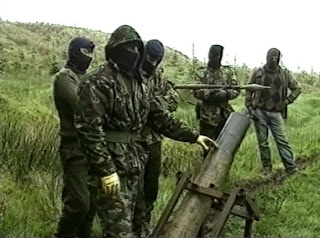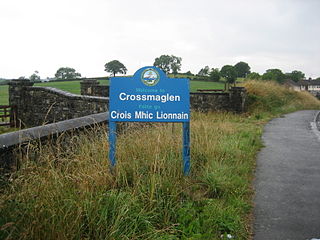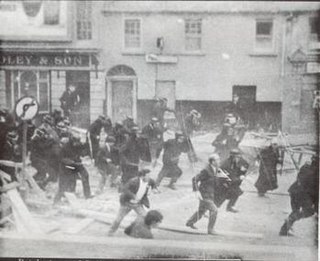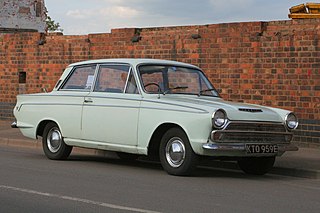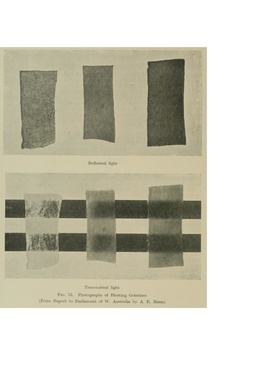This article lists the major violent and political incidents during the Troubles, peace process, and a dissident campaign in Northern Ireland, starting in the late 1960s until the present day. The Troubles was a period of conflict in Northern Ireland involving republican and loyalist paramilitaries, the British security forces, and civil rights groups. The Troubles is usually dated from the riots of 1968 through the Good Friday Agreement of 1998. However, sporadic violence continued after this point. Those that continued violence past this point are referred to as "dissident republicans and loyalists". The Troubles, between 1968 and 1998, claimed roughly 3500 lives while the Dissident Irish Republican Campaign 1998–present, has claimed around 150 lives. By 2019, interethnic and intercommunal violence petered out to near non-existence; nefarious activity largely consists of street and drugs-related crimes and robberies.
The Troubles in Armagh recounts incidents during The Troubles in Armagh, County Armagh, Northern Ireland; the violence was substantial enough for the city to be referred to by some as "Murder Mile". Over the span of 20 years, 24 individuals were killed in 13 different incidents.
The South Armagh Republican Action Force sometimes called simply the Republican Action Force was an Irish republican paramilitary group that was active from September 1975 to April 1977 during the Troubles in Northern Ireland. Its area of activity was mainly the southern part of County Armagh. According to writers such as Ed Moloney and Richard English, it was a covername used by some members of the Provisional IRA South Armagh Brigade. The journalist Jack Holland, alleged that members of the Irish National Liberation Army (INLA) were also involved in the group. During the same time that the South Armagh Republican Action Force was active the INLA carried out at least one sectarian attack that killed Protestant civilians using the covername "Armagh People's Republican Army". According to Malcolm Sutton's database at CAIN, the South Armagh Republican Action Force was responsible for 24 deaths during the conflict, all of whom were classified as civilians.
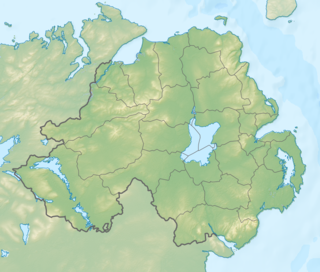
On 28 February 1985, the Provisional Irish Republican Army (IRA) launched a heavy mortar attack on the Royal Ulster Constabulary (RUC) base at Corry Square in Newry, Northern Ireland. The attack killed nine RUC officers and injured almost 40 others; the highest death toll ever suffered by the RUC. Afterwards, a major building scheme was begun to give police and military bases better protection from such attacks.
This is a timeline of actions by the Irish National Liberation Army (INLA), an Irish republican socialist paramilitary group. Most of these actions took place as part of its 1975–1998 campaign during "the Troubles" in Northern Ireland. The INLA did not start claiming responsibility for its actions under the INLA name until January 1976 at which point they had already killed 12 people, before then they used the names People's Liberation Army(PLA) & People's Republican Army(PRA) to claim its attacks.
This is a chronology of activities by the Provisional Irish Republican Army (IRA) from 1980 to 1989. For actions before and after this period see Chronology of Provisional Irish Republican Army actions.
This is a chronology of activities by the Provisional Irish Republican Army (IRA), from 1990 to 1999. For actions before and after this period see Chronology of Provisional Irish Republican Army actions.
The Troubles in Ardoyne lists incidents during the Troubles in the Ardoyne district of Belfast, Northern Ireland.
The Derry Brigade also known as the South Derry Brigade of the Provisional Irish Republican Army (IRA) operated in Derry, County Londonderry, Northern Ireland, during the Troubles. The Derry Brigade along with the Belfast Brigade, East Tyrone Brigade and the South Armagh Brigade were the four most active IRA Brigade areas during the conflict between 1969 and 1998.
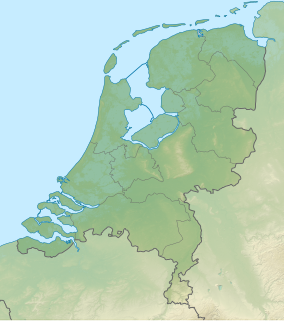
The Provisional IRA carried out two separate attacks on the same day on 1 May 1988 against British military personnel in the Netherlands which resulted in the deaths of three RAF members and another three being injured. It was the worst attack suffered by the British security forces during The Troubles from 1969 to 1998 on mainland Europe.

The Bessbrook bombing took place on the 17 April 1979 when four Royal Ulster Constabulary (RUC) officers were killed when the Provisional IRA exploded an estimated 1,000 pound roadside van bomb at Bessbrook, County Armagh, believed to be the largest bomb used by the IRA up to that point.
On 5 April 1975 Irish Republican paramilitary members killed a UDA volunteer and four Protestant civilians in a gun and bomb attack at the Mountainview Tavern on the Shankill Road - the heart of Loyalist Belfast. The attack was claimed by the Republican Action Force believed to be a covername used by Provisional IRA (IRA) volunteers. Earlier in the day, two Catholic civilians were killed in a bomb attack in a Belfast pub carried out by the Protestant Action Force a name used by the Ulster Volunteer Force to claim some attacks. An elderly Catholic man was shot later the same night by Loyalists bringing the death toll to eight for the day.

The Attack on RUC Birches barracks was an attack on 11 August 1986, the East Tyrone Brigade of the Provisional Irish Republican Army (IRA) attacked the Royal Ulster Constabulary (RUC) base at The Birches near Portadown, in North Armagh Northern Ireland. The unmanned base was first raked with gunfire before being completely destroyed by a 200 pounds (91 kg) bomb, which was driven through the gate of the base in the bucket of a JCB digger.

The Killeen Landmine attack took place on the 20 May 1985 when four Royal Ulster Constabulary (RUC) officers were killed when the Provisional IRA exploded an estimated 1,000 pound roadside bomb hidden in a trailer at Killean, County Armagh. The attack occurred just three months after nine RUC officers were killed and 37 injured in the 1985 Newry mortar attack.

On the night of 17 March 1978 at around 21:20 a Provisional Irish Republican Army (IRA) unit and a Special Air Service (SAS) unit became engaged in a shoot out in a field in Lisnamuck, near Maghera, County Londonderry, Northern Ireland. The leader of the IRA unit was Francis Hughes who was from Bellaghy, County Londonderry, who at that time was the "most wanted man" in Northern Ireland when a year earlier on 18 April 1977, Hughes, Dominic McGlinchey and Ian Milne were travelling in a car near the town of Moneymore when an RUC patrol car carrying four officers signalled them to stop. The IRA members attempted to escape by performing a u-turn, but lost control of the car which ended up in a ditch. They abandoned the car and opened fire on the RUC patrol car, killing two officers and wounding another, before running off through fields. A second RUC patrol came under fire while attempting to prevent the men fleeing, and despite a search operation by the RUC and British Army (BA) the IRA members escaped.

The Strand Bar Bombing was a gun and bomb attack carried out by the Loyalist Paramilitary organisation Ulster Volunteer Force (UVF) in Belfast in 1975. The blast destroyed most of the building and killed six civilians and injured about 50 more.

On 21 December 1978, three British soldiers were shot dead when the Provisional IRA's South Armagh Brigade ambushed an eight-man British Army foot patrol in Crossmaglen, County Armagh, Northern Ireland.
The following is a timeline of Northern Irish conflict actions which took place in the Republic of Ireland between 1969 and 1998. It includes Ulster Volunteer Force bombings such as the Dublin and Monaghan bombings in May 1974, and other Loyalist bombings, the last of which was in 1997. These attacks killed dozens of people. Actions by Irish Republicans include deadly bombings, prison escapes, kidnappings, and gun battles between the Gardaí (police) and the Irish Defence Forces against Republican gunmen from the Irish National Liberation Army, the Provisional Irish Republican Army, and a socialist-revolutionary group, Saor Éire. These attacks killed a number of civilians, police, soldiers, and Republican terrorists.

